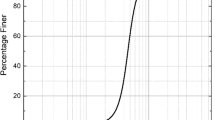Abstract
The whole of the northeast region of India lies in the seismic zone V. Barak River flows through the Silchar town of Assam. Several construction projects utilize the sand extracted from the Barak river for carrying out their operations; hence, its dynamic analysis becomes important. This study aims to experimentally investigate the dynamic behavior of Barak river sand in dry conditions by varying influencing parameters such as confining pressure and relative density, at a very low strain condition. The most important parameters in the dynamic analysis of soil include shear modulus and damping ratio, which were evaluated using resonant column apparatus in the torsional mode of vibration. The sand samples were prepared by compacting to relative densities of 30, 50, and 65% and tested at confining pressures of 50, 100, and 200 kPa. It was observed that with an increase in strain percentage, the shear modulus of the test sand decreased, but the damping ratio values increased. Shear modulus values obtained were found to be proportional to confining pressure and relative density, but the damping ratio followed an inverse trend. The outcomes of the present study can be implemented in the designing of foundations and structures exposed to dynamic loads.









Similar content being viewed by others
References
Das S, Bhowmik D (2020) Dynamic behaviour of sand-crumbed rubber mixture at low strain level. Geotech Geol Eng 38:6611–6622. https://doi.org/10.1007/s10706-020-01458-4
Dutta TT, Saride S (2016) Influence of shear strain on the Poisson’s ratio of clean sands. Geotech Geol Eng 34:1359–1373
Dutta TT, Saride S (2016) Dynamic properties of moderately expansive soil stabilized with class C fly ash. Geo-Chicago 2016:949–958
Vucetic M, Dobry R (1991) Shear strain for the first cycle of unidirectional cyclic shear loading. The relation consists of the initial loading curve OD, the unloading branch of the loop DEC, and the reloading branch CFD. The loop in Fig. 1(a) is somewhat idealized in th. J Geotech Eng 117:89–107
Zhang J, Andrus RD, Juang CH (2005) Normalized shear modulus and material damping ratio relationships. J Geotech Geoenviron Eng 131:453–464. https://doi.org/10.1061/(asce)1090-0241(2005)131:4(453)
Khan Z, El Naggar MH, Cascante G (2011) Frequency dependent dynamic properties from resonant column and cyclic triaxial tests. J Franklin Inst 348:1363–1376. https://doi.org/10.1016/j.jfranklin.2010.04.003
Das BM, Luo Z (2016) Principles of soil dynamics. Cengage Learning
Ishimoto M, Iida K (1937) Determination of elastic constants of soils by means of vibration methods. Part 2. Modulus of rigidity and Poisson’s ratio. Bull Earthq Res Institute, Univ Tokyo 15:67–85
Feng Z-Y, Sutter KG (2000) Dynamic properties of granulated rubber/sand mixtures. Geotech Test J 23:338–344
Madhusudhan BN (2011) Dynamic properties of dry to fully saturated states using resonant column and bender element tests
Mog K, Anbazhagan P (2022) Evaluation of the damping ratio of soils in a resonant column using different methods. Soils Found 62:101091
Zhang XJ, Aggour MS (1996) Damping determination of sands under different loadings. In: Proceedings of the Eleventh World Conference of Earthquake Engineering. Elsevier Science Ltd. Paper
Wichtmann T, Triantafyllidis T (2013) Effect of uniformity coefficient on g/gmax and damping ratio of uniform to well-graded quartz sands. J Geotech Geoenviron Eng 139:59–72. https://doi.org/10.1061/(asce)gt.1943-5606.0000735
Amir-Faryar Behzad (2012) Dynamic properties of fiber reinforced clay. In: Proceedings of 15th World Conference in Earthquake Engineering
Maher BMH, Member A, Woods RD (1990) Dynamic response of sand reinforced with randomly distributed fibers. J Geotech Eng 116:1116–1131
Pistolas GA, Anastasiadis A, Pitilakis K (2018) Dynamic behaviour of granular soil materials mixed with granulated rubber: effect of rubber content and granularity on the small-strain shear modulus and damping ratio. Geotech Geol Eng 36:1267–1281. https://doi.org/10.1007/s10706-017-0391-9
Akbulut S, Arasan S, Kalkan E (2007) Modification of clayey soils using scrap tire rubber and synthetic fibers. Appl Clay Sci 38:23–32. https://doi.org/10.1016/j.clay.2007.02.001
Das S, Bhowmik D (2020) Small-strain dynamic behavior of sand and sand-crumb rubber mixture for different sizes of crumb rubber particle. J Mater Civ Eng 32:1–9. https://doi.org/10.1061/(asce)mt.1943-5533.0003425
Bhattacharya LGS (2012) Site-specific earthquake response study for hazard assessment in Kolkata city, India. Nat Hazards 61:943–965. https://doi.org/10.1007/s11069-011-9940-3
Materials T (1994) by the bender element and resonant column tests. 519–526
Dammala PK, Krishna AM, Bhattacharya S et al (2017) Dynamic soil properties for seismic ground response studies in Northeastern India. Soil Dyn Earthq Eng 100:357–370. https://doi.org/10.1016/j.soildyn.2017.06.003
Madhusudhan BN, Senetakis K (2016) Evaluating use of resonant column in flexural mode for dynamic characterization of Bangalore sand. Soils Found 56:574–580
Kokusho T (1980) Cyclic triaxial test of dynamic soil properties for wide strain range. Soils Found 20:45–60
Stokoe KH, Darendeli MB, Andrus RD, Brown LT (1999) Dynamic soil properties: laboratory, field and correlation studies. In: Earthquake geotechnical engineering. pp 811–845
Funding
Not applicable.
Author information
Authors and Affiliations
Corresponding author
Ethics declarations
Conflicts of interest
The authors announce that there is no known conflict of interest with this publication.
Additional information
Publisher's Note
Springer Nature remains neutral with regard to jurisdictional claims in published maps and institutional affiliations.
Rights and permissions
Springer Nature or its licensor (e.g. a society or other partner) holds exclusive rights to this article under a publishing agreement with the author(s) or other rightsholder(s); author self-archiving of the accepted manuscript version of this article is solely governed by the terms of such publishing agreement and applicable law.
About this article
Cite this article
Gautam, Dubey, P., Mazumdar, A. et al. Dynamic Behavior Analysis of Barak River Sand Using Resonant Column Apparatus. Indian Geotech J (2024). https://doi.org/10.1007/s40098-024-00968-9
Received:
Accepted:
Published:
DOI: https://doi.org/10.1007/s40098-024-00968-9




